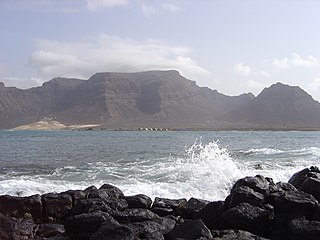
Fogo is an island in the Sotavento group of Cape Verde. Its population is 35,837 (2015), with an area of 476 km2. It reaches the highest altitude of all the islands in Cape Verde, rising to 2,829 metres above sea level at the summit of its active volcano, Pico do Fogo.

Santo Antão is the westernmost island of Cape Verde. At 785 km2 (303 sq mi), it is the largest of the Barlavento Islands group, and the second largest island of Cape Verde. The nearest island is São Vicente to the southeast, separated by the sea channel Canal de São Vicente. Its population was 38,200 in mid 2019, making it the fourth most populous island of Cape Verde after Santiago, São Vicente and Sal. Its largest city is Porto Novo located on the southern coast.

Santa Luzia is an island of the Barlavento archipelago in Cape Verde located between São Nicolau and São Vicente, the channel of Santa Luzia separates the island of São Vicente and is 8 km wide. The area is 34.2 km². Like all Cape Verdean islands, it is of volcanic origin. The highest point is Topona. Santa Luzia is 12.4 km long and 5.3 km wide.

Santiago is the largest island of Cape Verde, its most important agricultural centre and home to half the nation's population. Part of the Sotavento Islands, it lies between the islands of Maio and Fogo. It was the first of the islands to be settled: the town of Ribeira Grande was founded in 1462. Santiago is home to the nation's capital city of Praia.

Monte Verde is a mountain in the eastern part of the island of São Vicente, Cape Verde. At 744 m elevation, it is the island's highest point. The mountain is located 6 km (4 mi) east of the city centre of Mindelo.

Echium stenosiphon is a plant species of the family Boraginaceae. The species is endemic to Cape Verde. Its local name is língua-de-vaca, a name that may also refer to the related species Echium vulcanorum and Echium hypertropicum. The plant is used in traditional medicinal for a cough syrup.
Limonium jovibarba is a species of flowering plants of the family Plumbaginaceae. The species is endemic to Cape Verde. It is listed as critically endangered by the IUCN. The species was named by Carl Ernst Otto Kunze in 1891. Its local name is carqueja, a name that may also refer to the related species Limonium brunneri and Limonium braunii.
Sonchus daltonii is a species of flowering plants of the family Asteraceae. The species is endemic to Cape Verde. It is listed as endangered by the IUCN. The genus was named by Philip Barker Webb in 1849. Its local name is coroa-de-rei.
Conyza feae is a species of aster flowers that belong to the family Asteraceae. The species is endemic to Cape Verde. It is listed as an endangered plant by the IUCN. First described as Nidorella feae, it was placed in the genus Conyza by Hiram Wild in 1969. The specific name feae refers to the Italian naturalist Leonardo Fea. Its local name is losna-brabo or losna-bravo. The plant plays a role in traditional medicine.

Conyza varia is a species of flowering plants of the family Asteraceae. The species is endemic to Cape Verde. It is listed as an endangered plant by the IUCN. First described as Erigeron varius by Philip Barker Webb, it was placed in the genus Conyza by Hiram Wild in 1969. Its local name is marcelinha or tabua, tabuinha. The plant plays a role in traditional medicine: crushed and heated leaves are used to treat external inflammations.
Conyza pannosa is a species of flowering plants of the family Asteraceae. The species is endemic to Cape Verde. It is listed as an endangered plant by the IUCN. The plant was named by Philip Barker Webb in 1849. Its local name is taba.

Lavandula rotundifolia is a species of flowering plants of the family Lamiaceae. The species is endemic to Cape Verde. The species was named by George Bentham in 1833. Its local name is aipo. The plant is used in traditional medicine for treating stomach aches.
Verbascum capitis-viridis is a species of flowers that belongs to the family Scrophulariaceae. The species is endemic to Cape Verde. The species was first named Celsia insularis by Murbeck, but Arthur Huber-Morath placed it in the Verbascum species in 1973. Its local name is sabão de feticeira.
Theridion cuspulatum is a species of tangle-web spiders of the family Theridiidae. It is endemic in Cape Verde.

Asteriscus smithii is a species of flowering plants of the family Asteraceae. The species is endemic to the island of São Nicolau, Cape Verde. It is listed as critically endangered due to its very restricted area of occupancy and its low population size. Its local name is macela-de-gordo.
Tornabenea is a genus of plants in the family Apiaceae. The genus was described by Filippo Parlatore in 1850.
Monomorium boltoni is a species of insects of the family Formicidae, the ants. The species is endemic to Cape Verde, where it is restricted to the island of São Nicolau. The species was first described in 1987.
Launaea gorgadensis is a species of flowering plants of the family Asteraceae. The species is endemic to Cape Verde. It is listed as a critically endangered plant by the IUCN.
Launaea picridioides is a species of flowering plants of the family Asteraceae. The species is endemic to Cape Verde. It is listed as a vulnerable species by the IUCN.
Tolpis farinulosa is a species of flowering plants of the family Asteraceae. The species is endemic to Cape Verde. It is listed as endangered by the IUCN. Its local name is mato-branco, a name that may also refer to the species Phagnalon melanoleucum and Verbascum cystolithicum.








